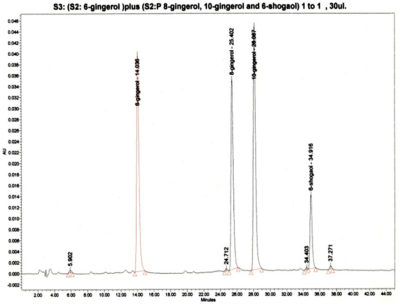A bioactive ingredient of ginger root (Zingiber officinale), a medicinal plant having anti-nausea, anti-inflammatory, and anti-carcinogenic properties and a carminative effect
- Catalog No: APH-02033
- CAS Number: 23513-15-7
- Chemical Formula: C21H34O4
- Molecular Weight: 350.50
- Purity: > 98% determined by HPLC
- Appearance: Light yellow powder
- Solubility: Soluble in methanol and ethanol
- Stability: Unstable at room temperature in the presence of oxygen and light. Stable over extended period at -20°C.
- Storage: -20°C
- Shipping: On ice (5°C)
- Handling: Avoid exposure to oxygen and direct sunlight.
Source:
10-Gingerol is isolated from the rhizomes or roots of the plant Zingiber officinale (ginger). It is a perennial reed-like plant with annual leafy stems, about a meter (3 to 4 feet) tall.
Ginger produces clusters of white and pink flower buds that bloom into yellow flowers. Because of its aesthetic appeal and the adaptation of the plant to warm climates, ginger is often used as landscaping around subtropical homes. Traditionally, the root is gathered when the stalk withers; it is immediately dried, scalded, or washed and scraped, to kill it and prevent sprouting.
10-Gingerol is isolated from ginger root using ethanol and other organic solvents followed by chromatographic purification. Aphios isolates 10-gingerol utilizing near-critical and supercritical fluids using CXF and CXP enabling technology platforms as alternatives to ethanol and conventional organic solvents techniques.
Biological Activity:
Ginger (Zingiber officinaleRoscoe, Zingiberaceae) is a medicinal plant that has been widely used in Chinese, Ayurvedic and other global herbal medicinal practices since ancient times for a wide array of ailments including arthritis, rheumatism, sprains, muscular aches, pains, sore throats, cramps, constipation, indigestion, vomiting, hypertension, dementia, fever, infectious diseases and helminthiasis (Ali et al., 2008).
Ginger has been approved for use by Germany’s Commission E, the agency responsible for regulating the use of herbal products in that country (Blumenthal, 1998). Ginger has recently been studied scientifically for its effect on nausea and vomiting associated with motion sickness, surgery, pregnancy and cancer chemotherapy.
There may be several mechanisms of action in play relative to the antiemetic properties of ginger. It has been reported that the antiemetic qualities may be derived from ginger’s anti-serotonin 3 effects on the gastrointestinal and central nervous system (Chaiyakunapruk et al., 2006). In a study of guinea pig ileum, it was found that certain ingredients of ginger (6-, 8- and 10-gingerols) inhibit the anti-serotonin 3 receptor function (Huang et al., 1991 and Yamahara et al., 1989). In addition, these active ingredients have been shown to affect gastric motility and potentially have an antispasmodic effect on the gastrointestinal system (Hashimoto et al., 2002 and Suekawa et al., 1984).
References:
Ali B, Blunden G, Tanira M and Nemmar A. (2008). Some phytochemical, pharmacological and toxicological properties of ginger (Zingiber officinale Roscoe): A review of recent research. Food and Chemical Toxicology. 46(2): 409-420.
Blumenthal M, Busse W, Goldberg A, Gruenwald J, Hall T, Klein S, Riggins C and Rister R. (1998). The Complete German Commission E monographs. Therapeutic Guide to Herbal Medicines, Austin TX, American Botanical Council.
Chaiyakunapruk N, Kitikannakorn N, Nathisuwan S, Leeprakobboon K and Leelasettagool C. (2006). The efficacy of ginger for the prevention of postoperative nausea and vomiting: a meta-analysis. Am. J. Obstet. Gynecol. 194, 95–99.
Chen C, Kuo M, Wu C and Ho C. (1986). Pungent Compounds of Ginger (Zingiber officinale Roscoe) Extracted by Liquid Carbon Dioxide. Journal of Agriculture and Food Chemistry 34(3): 477-480.
Hashimoto K, Satoh K, Murata P, Makino B, Sakakibara I, Kase Y, Ishige A, Higuchi M and Sasaki H. (2002). Component of Zingiber officinale that improves the enhancement of small intestinal transport. Planta Medica. 68:936-9.
Huang Q, Iwamoto M, Aoki S, Tanaka N, Tajima K, Yamahara J, Takaishi Y, Yoshida M, Tomimatsu T and Tamai Y. (1991). Anti-5-hydroxytryptamine 3 effect of galanolactone, diterpenoid isolated from ginger. Chem. Pharm. Bull. (Tokyo) 39, 397–399.
Suekawa M, Ishige A, Yuasa K, Sudo K, Aburada M and Hosoya E. (1984). Pharmacological studies on ginger: I. Pharmacological action of pungent constituents, (6)-gingerol and (6)-shogaol. J Pharmacobiodyn. 7:836-48.
Yamahara J, Rong H, Iwamoto M, Kobayashi G, Matsuda H and Fujimura H. (1989). Active components of ginger exhibiting anti-serotonergic action. Phytother. Res. 3, 70–71.

